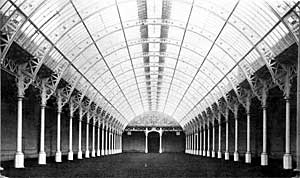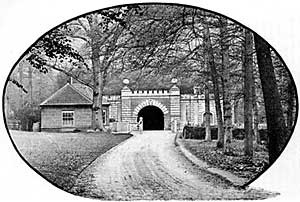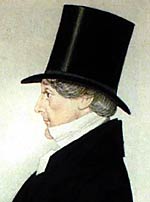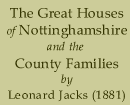< Welbeck | Contents | Winkburn >
Welbeck (contd.)

The riding school built by the 5th Duke of Portland in the 1860s.
Foremost amongst the outbuildings connected with Welbeck Abbey is the new riding school, a building of extraordinary beauty, and of gigantic proportions. It vast floor is fresh-covered with soft tan, which is never allowed to get into disorder. Here, most days, the horses were exercised, generally in the presence of their owner, who had the reputation of being a keen judge of horse flesh. The riding house measures about 380 feet in length, 112 wide, and 50 feet high. Its roof is of glass and iron, semi-circular in shape, and richly ornamented. The walls are of stone, and the interior contains some fifty cast-iron columns. There are upwards of eight thousand gas jets, these being placed in circles round the capitals of each of the fifty columns. The roof is divided into three compartments, the centre one being of glass and iron, and the two side ones of pitch pine, covered with copper tiling. There is an underground passage from the abbey to the riding house ; his grace entered the latter building at one of the corners, and from this point he witnessed the performances of his horses. In another part of the grounds there is a "tan gallop " for the exercise of horses. The whole length of this—1,270 feet, is covered with glass. The Welbeck stables are as large as a small village. The hunting stables stand on a square acre of ground, and are arranged in the form of a quadrangle. There is accommodation here for some fifty or sixty horses. The late Duke took a great interest in his horses ; he knew them all by name, and would sometimes feed them with his own hands. His grace’s stud consisted of more than a hundred horses. This number included carriage horses, and they were most carefully tended by a large staff of grooms and stablemen. There is stabling for about a dozen strangers," so that tradesmen, and others, who drive to Welbeck on business are allowed to put up their horses. In the coach house were carriages of every variety—landau, brougham, and State carriage. These were seldom, or never, used, though they were always in readiness. The Duke’s favourite carriage was a sort of waggonette, completely covered with a thick curtain arranged in the form of a cube, with flat top. Cut in the curtain, are some half-dozen " eye-holes," containing oval glasses, so that a person sitting in the carriage could see what was going on about him without the slightest difficulty. Inside, the soft cushions had a covering of dark green, and the carriage was old-fashioned, and exceedingly comfortable. The harness room contains a large collection of harness of all kinds, which is hung in glass cases, and is always ready for use. In one of these upright cases is a set of State harness, which belonged to the late Duke of Portland. I have just time to take a run through the cow houses and dairy. The Duke of Portland had some famous Alderneys, and they were housed in most comfortable quarters. The cow house, which is of great size, is divided into stalls, each stall being of galvanised metal and slate. The roof is of pitch pine, and the house is supplied with revolving iron shutters, so that the part which is open in good weather, can be closed in days of cold. There is a second cow house, of similar proportions to this one, to which the animals are transferred when the place requires cleaning. The doors by which all these outhouses are entered are large and beautifully grained, and supplied with brass handles, kept in a perfect state of polish. The graining work, I am told, was done by a tramp, who, coming to Welbeck, and applying for work, was at once "set on" by the clerk of the works, and he turned out to be a thoroughly competent workman. The dairy is a pretty little stone building. It has a flooring of Minton’s encaustic tiles, from the centre of which springs a crystal fountain, set in a marble basin. The china milk dishes are placed on marble benches, and the cream jars, higher up in niches let into the walls. The workpeople employed on the estate can have the very best milk and butter from this dairy, at something under the market value.

Entrance to tunnel on the Welbeck estate.
The workshops at Welbeck are much too vast to admit of anything but a casual mention. There are great sheds, in which every kind of work is done by skilled workmen, aided by the very best machinery. In one room circular saws are whirring, and doing their speedy work; in another blacksmiths’ fires are burning, and men are striking sparks from large pieces of hot iron ; in another gigantic shed men are repairing carts and implements belonging to the estate; in another a huge slab of stone is succumbing to the fell movement of a frame-saw, whilst another piece is being smoothed by a "rubber," which is kept in perpetual motion by a small vertical engine. The waste steam from the boilers has been put to an excellent use ; by it the whole of the workshops and buildings connected with them are heated, the steam passing through iron pipes—an admirable arrangement. There are joiners’ shops, painters’ shops, and plumbers’ shops, which help to form a set of workshops, such as none but the largest contractors possess. In another part of these very extensive work yards are stacks of timber—giant slices of oak, sound and hard as adamant, and close by there are great boles of trees, which have been brought from the forest by one or other of the five monster traction engines that are housed in sheds by themselves. Other great sheds are filled with iron rods of all thicknesses, and iron piping of every dimension, for all manner of work is done in these shops. A new set of offices, the walls of stone, and the interior fitted in the very best style, with stone staircases, clerk’s rooms, private rooms, postman’s rooms, lavatories, and heated by piping, through which passes the "exhaust" steam from the adjoining works, have recently been completed, or nearly so, and opposite a new house for the house steward, with spacious and expensively-fitted rooms, in which pitch pine has been largely employed, has just been erected. Near to, and connected with the works, the late Duke caused to be built an immense fire-proof store, which is divided into three compartments, the roof of each compartment being of iron, and the inner sliding doors of the same metal, the floor being of asphalte. A great block of stabling, with stalls of iron and pitch pine, have here been built, and a new fire engine house, with special stabling accommodation, was, at the time alluded to, scarcely out of the builder’s hands. I ought to have stated that in the house, and about the works, are ample appliances for suppressing an outbreak of fire. In the midst of the workshops there is an engine shed, with a fire engine, capable of throwing a heavy stream of water some seventy feet high, with hose reels, salvage waggons, and all the necessary appliances.
The gardens and pleasure grounds of Welbeck are so extensive that it would be impossible to see them thoroughly in a day. There are fifty acres of pleasure ground, composed of rare young shrubs, firs from Mexico and India, of grassy lawns, smooth and soft as velvet, intersected by a broad and continuous gravel walk, flagged in the centre. In one part of the pleasure grounds the late Duke caused to be made a large out-door skating rink, surrounded by graceful shrubs, which preserve their freshness through the cold weather. There is a large circular arrangement of iron near the foot of the lake,—a boathouse, and I am told that the top of this has been filled in with asphalte, so that it too could be used as a skating rink. The kitchen gardens cover an immense area of ground, and produce every kind of fruit and vegetable. They are surrounded by high walls, and are now being made more extensive. There are long lengths of standard rose trees, which, in the summer time, furnish lines of colour and fill the air with a delicious perfume there are vast ranges of glass, where delicious fruits are forced— nectarines and grapes, in unheard of quantities. The kitchen gardens are formed in separate compartments, and they extend as far as the Mansfield turnpike road, near to the Welbeck Gas Works. To hasten the ripening of the apricots, which occupy a wall one thousand feet in length, Rendle’s patent lean-to glass has been employed. This is a moveable arrangement, covering the whole length of the wall, and it is also used to protect the strawberry beds, on the opposite side of the path, which are exactly as long as the wall. At one end of the kitchen gardens a broad high wall of stone, with a carriage entrance, has just been built. The Duke made most lavish presents of game and fruit, and he supplied some of his friends with horses and ponies.

The 5th Duke of Portland (1800-1879).
And now a word concerning the late owner of this magnificent domain. His Grace William John Cavendish Scott-Bentinck, fifth Duke of Portland, Marquis of Tichfield, Earl of Portland, Viscount Woodstock, Baron of Cirencester, and co-heir to the Barony of Ogle, of Welbeck Abbey, Nottinghamshire; Fullarton House, Ayrshire; Langwell Goldspie, Caithness; Bothal Castle, Northumberland, and Harcourt House, Cavendish-square, London, succeeded his father, in 1854, having previously represented the borough of Lymn in the House of Commons. Though his grace took no active part in politics, he exhibited, amid the magnificent solitude of Welbeck, a very keen interest in matters of national importance, and current literature found its way into his hands. The late Duke of Portland lived amongst his people, by whom he was held in the highest esteem, and it may be said that he spent the last twenty years of his life in doing good, inasmuch as he gave employment in prosperous times, and in times when the labour market has been in a most unhappy condition, to thousands of workpeople. The present Duke has enjoyed the title long enough to win the esteem of all classes.
